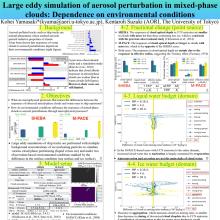Large eddy simulation of aerosol perturbation in mixed-phase clouds: Dependence on environmental conditions
Kohei
Yamasaki
Atmosphere and Ocean Research Institute, the University of Tokyo
Poster
Aerosol-polluted tracks such as ship tracks are natural phenomena where emitted aerosols perturb radiative properties of clouds. It has been shown that responses of warm clouds to aerosol perturbations depend on their environmental conditions. Although a previous observational study and a simulation study indicate that cloud albedo responses in mixed-phase clouds are weaker than in warm clouds, their cases are still limited and it is unclear how environmental conditions influence the responses of mixed-phase clouds to aerosol perturbations through microphysical processes. This lack of understanding motivated us to conduct a suite of large eddy simulations under two observation-based environmental conditions marked by the difference in the surface condition (sea surface and ice surface) and with multiple background concentrations of ice nucleating particles. Cloud condensation nuclei are emitted from a point source or to the entire domain. For the former case, the magnitudes of cloud radiative responses to aerosol perturbations are found to vary with background concentrations of ice nucleating particles in the manner that depends on the environmental condition. This dependency mainly arises from differing responses of the effective radius of cloud droplets, which is suggested to be determined by the size of background cloud droplets dependent on the environmental condition and by the size of newly activated numerous droplets specified in the model that appears to lead to a particular value of the effective radius regardless of the environmental condition. The evaporation of cloud droplets in the top liquid layer and the deposition in the middle mixed-phase layer largely offset each other, making the total liquid water content relatively steady in the latter half of the simulation period. In the presentation, we will also introduce and discuss the results of the latter case with nuclei emission over the entire domain in comparison to the point-source emission case.

yamasaki-kohei-poster.pdf
(7.9 MB)
Meeting homepage
